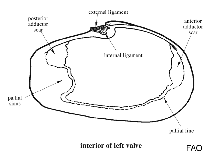Cochlodesma praetenue (Pulteney, 1799)
European spoon clamGoogle image | No image available for this species;
drawing shows typical species in Thraciidae.
Classification / Names आम नाम | उपशब्द | CoL | ITIS | WoRMS
Bivalvia | Not assigned | Thraciidae
Environment: milieu / climate zone / गहराई सीमा / distribution range पारिस्थितिकी
; गहराई सीमा 0 - 110 m (संदर्भ 125178). Temperate; 71°N - 29°N, 10°W - 49°E
Distribution देश | ऐफ ऐ ओ क्षेत्र | Ecosystems | संयोग | भूमिका
Northeast Atlantic, Mediterranean and Western Indian Ocean: from Scotland to Norway, east to Persian Gulf.
Length at first maturity / आकार / Weight / Age
परिपक्व अवधि: Lm ? range ? - ? cm
Life cycle and mating behavior परिपक्व अवधि | पुनरुत्पत्ति | मछलीऔ का अंडे देना | Eggs | Fecundity | Larvae
Main reference
संदर्भ | संयोजक | सहयोगीयो
Kühne, S. and E. Rachor 1996 The macrofauna of a stony sand area in the German Bight (North Sea). Helgoländer Meeresunters 50:433-452. (संदर्भ 2707)
IUCN Red List Status
(संदर्भ 130435: Version 2025-1)
CITES status (संदर्भ 108899)
CMS (संदर्भ 116361)
Threat to humans
Human uses
| FishSource |
साधन
अधिक जानकारी
संघटक आहार
आहार खपत
परभक्षी
Max. ages / sizes
Length-weight rel.
Length-length rel.
Length-frequencies
Mass conversion
बहुतायत
इंटरनेट स्रोत
BHL | BOLD Systems | CISTI | DiscoverLife | FAO(Publication : search) | Fishipedia | GenBank (genome, nucleotide) | GloBI | Gomexsi | Google Books | Google Scholar | Google | PubMed | Tree of Life | Wikipedia (Go, खोज) | Zoological Record



